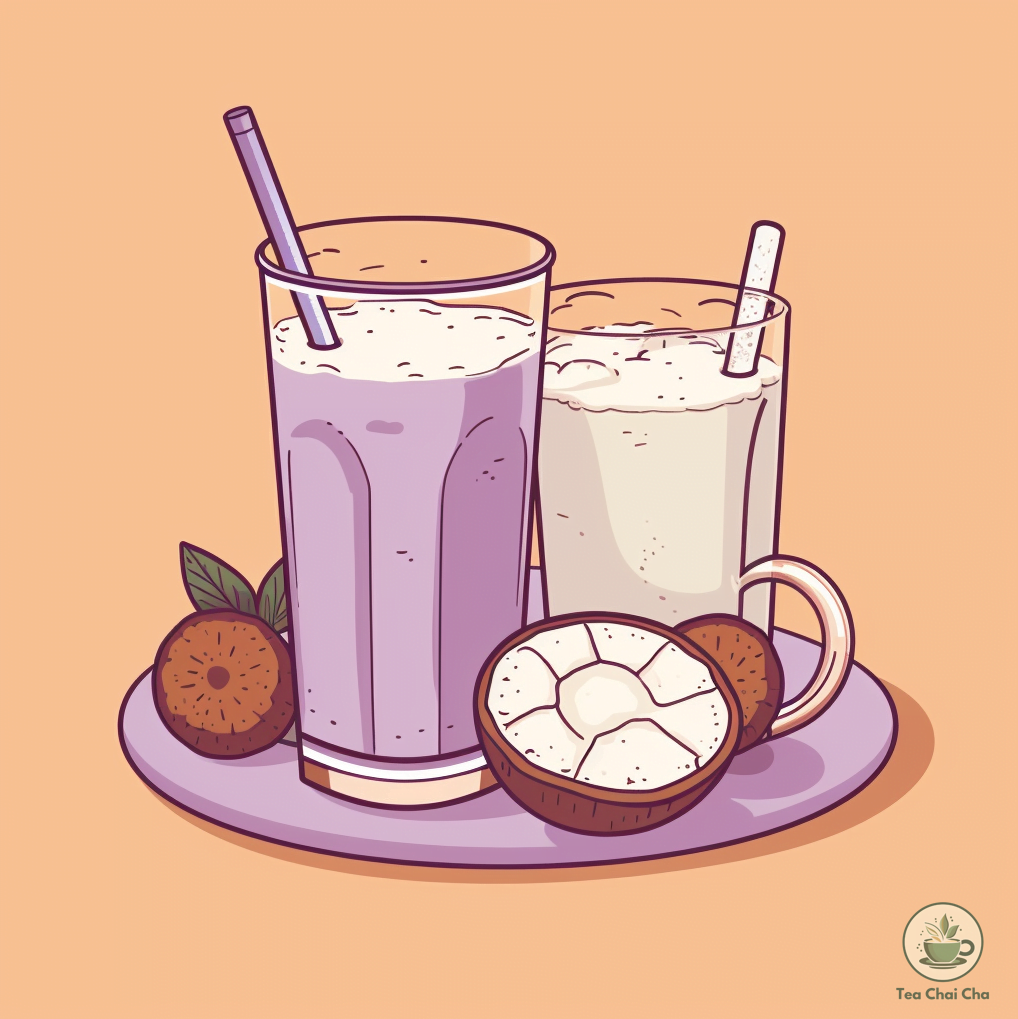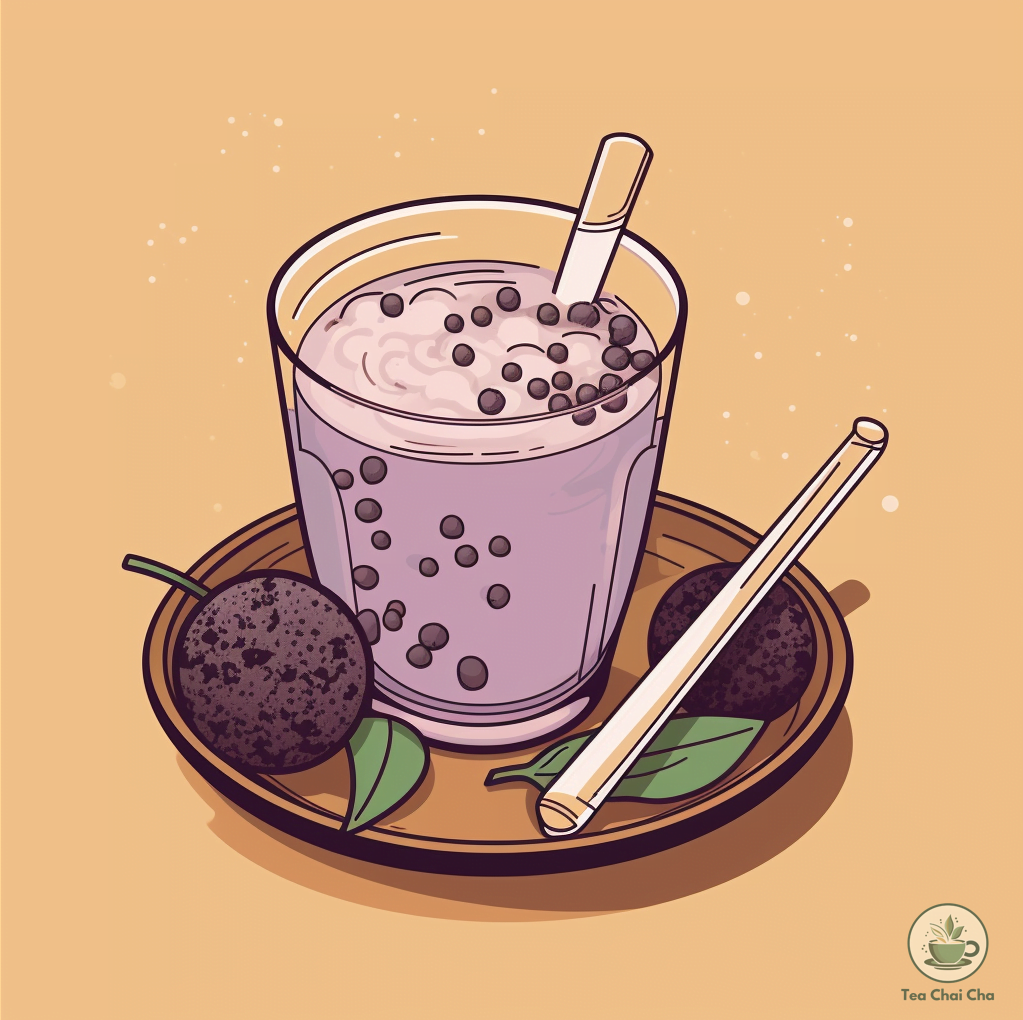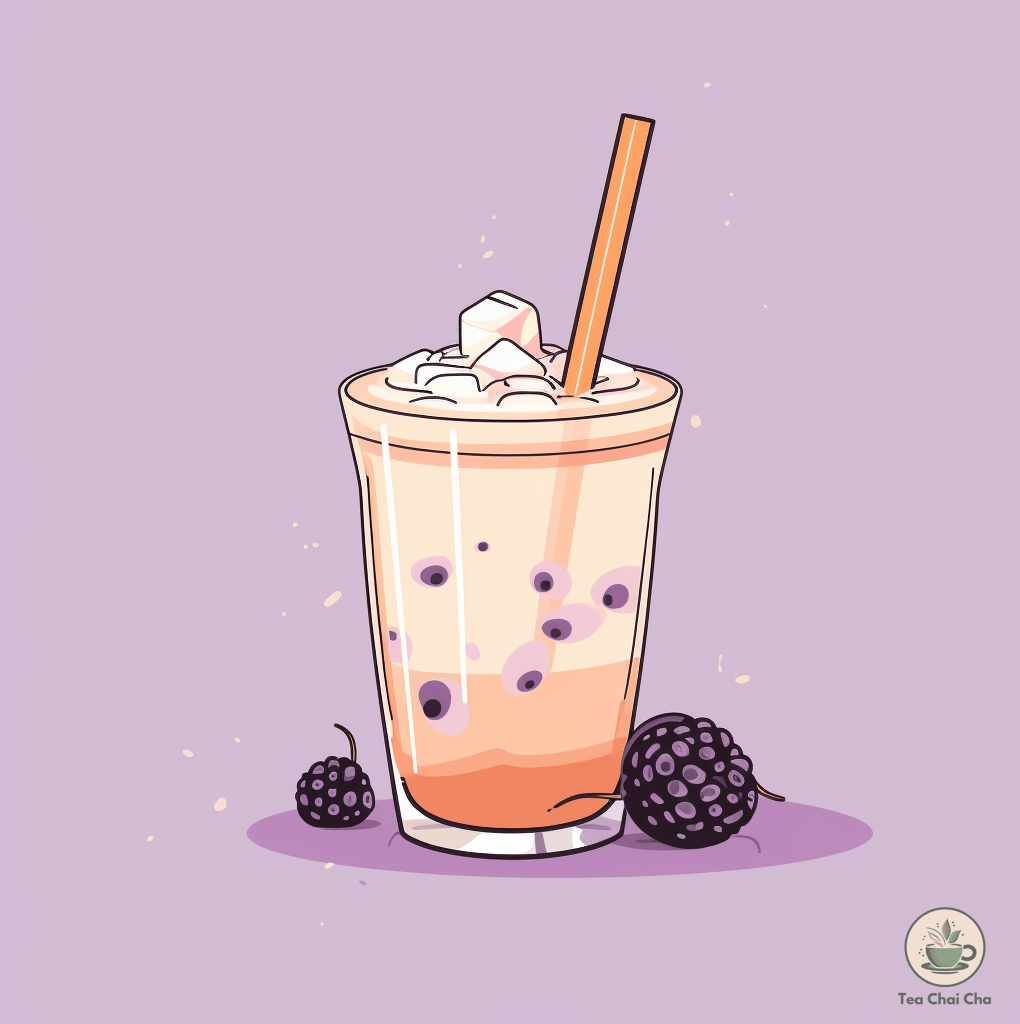Ever wondered what makes taro milk tea a worldwide sensation, or why it has managed to captivate the taste buds of so many?
Have you taken a sip and struggled to describe its unique flavor to your friends? Taro taste profile is not easy to pin down.
So, what does taro milk tea taste like?
Taro milk tea has a sweet and nutty taste with a hint of creamy vanilla. Some say it reminds them of buttered popcorn. Taro bubble tea made with fresh ground paste has a thicker, milkshake-like texture with a slight graininess.

What Is Taro Milk Tea?
Originating from East Asia, this creamy, refreshing beverage is made from the taro root—a starchy tuber with a mildly sweet taste—blended with milk and tea.
The unique purple hue and the intriguing flavor profile of this drink make it a standout in the vast landscape of milk teas.
What Does Taro Milk Tea Taste Like?
Taro milk tea is a unique and flavorful beverage. Derived from the taro fruit, taro milk tea taste like a combination of earthy, nutty, and mildly sweet notes. Many people say that taro tea taste like a sweet potato, with nutty and creamy finish.
The taro boba taste can be described as follows:
- Earthy: Taro tea exhibits a pronounced earthy essence, reminiscent of the taro root itself. This earthiness adds depth to the tea and is one of its defining characteristics.
- Nutty: Taro imparts a delightful nutty undertone to the tea, elevating its complexity and creating a pleasant contrast with the earthy notes.
- Mildly Sweet: While not overly sugary, taro tea carries a subtle sweetness that enhances the overall flavor profile. This mild sweetness makes the tea satisfying without being cloying.
- Smooth and Creamy: When prepared as a milk tea, taro tea becomes velvety and creamy, contributing to a luscious mouthfeel that enhances the overall drinking experience.
- Comforting: The combination of earthy, nutty, and sweet elements in taro tea creates a sense of warmth and comfort, making it a comforting beverage to savor.
- Versatile: Taro tea’s versatile nature allows it to be enjoyed in various forms, from traditional hot brewed tea to chilled iced tea, and even as a component in other drinks like taro milk tea and taro smoothies.

What Does Taro Taste Like?
Taro has a unique taste that you can describe as having a sweet and nutty flavor. It often has hints of vanilla. Taro root taste can also be characterized as subtly earthy.
The flavor profile of taro is both distinct and delightful, thus making it a popular ingredient in various culinary creations.
When you taste taro, you’ll experience a sweet and nutty sensation, similar to the taste of some nuts.
The root of the taro plant is where this flavor originates, and its taste is central to many dishes and beverages. Besides taro fruit’s flavor, it also brings a touch of creaminess to dishes and contributes to the overall richness of the flavors.
Whether you encounter taro in desserts, such as taro ice cream or cakes, or in savory dishes like taro chips or taro stir-fries, its unique taste profile adds a special element to the overall culinary experience.
Taro’s sweet and nutty essence, coupled with the subtle earthiness, makes it a favorite ingredient among food enthusiasts seeking new and exciting flavors.
What Does Taro Milk Taste Like?
Taro milk tastes like a creamy, nutty, and slightly sweet beverage. It has a unique earthy flavor from the taro root, combined with the smoothness of milk. The overall taste is comforting and delightful, with a subtle hint of sweetness.
Taro milk is a drink made with taro root and milk, similar to taro milk tea but without the tea component. It is a creamy and sweet beverage that highlights the natural flavors of taro and milk.
Taro milk is popular in many Asian countries. It is particularly famous in Taiwan and Southeast Asia, where taro is a common ingredient in various dishes and desserts.
The preparation of taro milk is quite straightforward. The taro root is cooked, mashed, or blended into a smooth paste, and then mixed with milk and sweetener to create a creamy and luscious drink.
The sweetness level can be adjusted to suit individual preferences. Taro milk can be served chilled over ice, or you can enjoy it warm if you prefer a comforting hot drink.
Taro milk is the best non-tea alternative for those who enjoy the earthy and nutty flavor of taro with the creaminess of milk.
It offers a refreshing and satisfying beverage option that is popular in various cafes and beverage shops, especially in places where taro is a beloved ingredient.
What Does Taro Boba Tea Taste Like?
Taro boba tea tastes yummy and creamy. It has a special nutty and earthy flavor from the taro root, and the boba pearls make it fun to drink.
Boba pearls are chewy and can come in different flavors, like classic tapioca or fruity varieties. The boba pearls are made using tapioca starch.
The starch is rolled into small balls and cooked until they turn chewy and soft. It has the right amount of sweetness that makes it a tasty treat.
People who love bubble tea really enjoy the unique and satisfying taste of taro boba tea with its delightful boba pearls.
What Does Taro Smoothie Taste Like?
A taro smoothie tastes creamy, rich, and slightly sweet with a distinct earthy and nutty flavor from the taro root.
It is made from taro root, which lends an earthy and nutty taste to the smoothie. The consistency is thick and velvety, thanks to the blending of taro with milk or a non-dairy alternative.
The overall taste of a taro smoothie is pleasantly sweet, balanced by the natural flavors of the taro. It has a comforting and mellow quality, making it a soothing and enjoyable beverage option.
The addition of ice in the blending process creates a refreshing and cooling effect, perfect for hot days or as a delightful treat any time of the year.
Taro smoothies are a popular choice for those who appreciate the unique taste of taro and enjoy a creamy, smooth texture in their beverages.
The fusion of the earthy taro flavor and the creamy consistency makes taro smoothies a favorite among smoothie enthusiasts.

Comparing Taro Milk Tea Taste to Popular Milk Teas
Here’s the comparison of various popular milk teas with taro bubble tea using the key aspects:
Taste of Taro Milk Tea vs. Matcha Milk Tea
Flavor: Taro milk tea has a sweet and nutty flavor with an earthy undertone, while matcha milk tea has a rich, grassy, and slightly bitter taste from the powdered green tea.
Color: Taro milk tea is typically purple or lavender, while matcha milk tea has a vibrant green color.
Ingredients: Taro milk tea uses taro root and milk, while matcha milk tea is made with matcha green tea powder and milk.
Taste of Taro Milk Tea vs. Thai Milk Tea
Flavor: Taro milk tea has a unique earthy and nutty taste from the taro root, while Thai milk tea is sweet and spiced with flavors like vanilla, star anise, and cinnamon.
Color: Taro milk tea is purple or lavender, while Thai milk tea has an orange hue from the addition of food coloring or natural ingredients like tamarind or orange blossom water.
Ingredients: Taro milk tea uses taro root, while Thai milk tea typically includes black tea, sweetened condensed milk, and spices.
Taste of Taro Milk Tea vs. Honeydew Milk Tea
Flavor: Taro milk tea has a nutty and sweet taste from the taro root, while honeydew milk tea has a refreshing and sweet flavor from the honeydew melon.
Color: Taro milk tea is purple or lavender, while honeydew milk tea is light green, resembling the fruit’s color.
Ingredients: Taro milk tea uses taro root, while honeydew milk tea is made with honeydew melon and milk.
Taste of Taro Milk Tea vs. Hokkaido Milk Tea
Flavor: Taro milk tea has an earthy and nutty taste from the taro root, while Hokkaido milk tea has a creamy and rich flavor, often enhanced with Hokkaido milk or cream.
Color: Taro milk tea is purple or lavender, while Hokkaido milk tea is typically a creamy beige color.
Ingredients: Taro milk tea uses taro root, while Hokkaido milk tea often uses Hokkaido milk or cream.

Is Taro Milk Tea Vegan?
Generally, taro milk tea is not considered vegan due to its use of milk and potential non-vegan ingredients in taro powder or other additives. However, you can easily make it vegan-friendly by making a few simple substitutions:
- Non-Dairy Milk: Replace regular milk with almond milk, oat milk, soy milk, coconut milk, or any other plant-based milk substitute. These alternatives provide a creamy texture without using animal products.
- Vegan Sweeteners: Instead of using honey or other non-vegan sweeteners, opt for vegan-friendly sweeteners like agave syrup, maple syrup, or any other plant-based sweetener.
By making these adjustments, you can enjoy a delicious and satisfying vegan version of taro milk tea, free from animal-derived ingredients.
It’s a great way to accommodate dietary preferences and restrictions while still enjoying the delightful taste of taro milk tea.
Taro Milk Tea Is Tasty But Is It Healthy?
The healthiness of taro milk tea depends on its ingredients and how you prepare it. Let me break it down:
Taro Root: Taro root is a nutritious vegetable that contains essential nutrients such as fiber, potassium, vitamin C, and vitamin E. It is also relatively low in calories and fat, making it a healthy addition to the drink.
Milk: The healthiness of the milk used in taro milk tea depends on the type of milk chosen. Dairy milk provides calcium and protein but may also contain saturated fats. Non-dairy alternatives like almond, oat, or soy milk offer plant-based benefits and can be lower in calories and saturated fats.
Sweeteners: The sweetness level in taro milk tea can be adjusted to personal preference. However, excessive use of sweeteners, especially refined sugars, can add empty calories and may not be considered healthy.
Additives: Some taro milk tea recipes may include toppings like boba pearls, which are often made from tapioca starch. While boba pearls themselves are generally low in fat and sodium, they are mostly carbohydrates and should be consumed in moderation.
To make a healthier taro milk tea, consider using fresh taro root or reputable taro powder, opting for lower-fat milk or non-dairy alternatives, and using natural sweeteners in moderation.
You can also control the amount of sweeteners and toppings added to tailor the drink to your health preferences.
While taro milk tea can be a tasty treat, it’s essential to enjoy it as part of a balanced diet and consume it in moderation. As with any beverage or treat, moderation is key to maintaining a healthy lifestyle.
Taro Milk Tea Recipe
Recipe by Tania FaysalCuisine: Asian4
servings15
minutes20
minutes400
kcal35
minutesGet ready to whip up a lip-smacking taro paste milk tea right in the comfort of your own crib. Here's the deal: grab some taro root, milk, tea, and your fave sweetener, and you're good to go. Follow this recipe to get a delicious glass of taro milk tea!
Ingredients
1 cup of peeled and diced taro root
1 cup of loose black tea leaves (or 3 tea bags)
4 cups of water
1 cup of milk (any variety will work, including non-dairy options)
Sugar or sweetener to taste
Optional: Boba pearls or other desired toppings
Directions
- Boil the Taro: In a medium pot, bring water to a boil. Add the diced taro root and boil until it's soft and easily pierced with a fork, about 15-20 minutes. Drain the taro and let it cool.
- Brew the Tea: In a separate pot, bring the 4 cups of water to a boil. Add the tea leaves or tea bags and let it steep for 3-5 minutes, or to your preferred strength. Once done, remove the tea leaves or bags and allow the tea to cool.
- Prepare the Taro: Once the taro is cool enough to handle, use a blender or food processor to blend the taro into a smooth, creamy paste.
- Combine: Add the taro paste to the brewed tea, stirring well to combine. Add in your milk and sweetener, adjusting to taste. If you prefer your drink cold, you can chill the mixture in the refrigerator or serve over ice.
- Serve: Pour your taro milk tea into glasses. If desired, add your boba pearls or other toppings, and enjoy!

How to Enjoy Taro Milk Tea at Its Best
Let me share with you how I enjoy taro milk tea at its absolute best.
-> Choose a Quality Taro Milk Tea
When I want to enjoy the best taro milk tea experience, I start by using high-quality ingredients. Whether I’m making it at home or visiting a tea shop, I make sure to use fresh taro root or reputable taro powder and my favorite type of milk, be it dairy or non-dairy.
-> Balance the Sweetness
One of the things I love about taro milk tea is that it’s not overly sweet. To enjoy it at its best, I recommend adding sweetener gradually, tasting as you go, until you find the perfect balance that suits your taste buds. This way, the natural sweetness of the taro root shines through, and it’s not overpowering.
-> Experiment with Toppings
Another way to elevate your taro milk tea experience is by getting creative with toppings. While classic boba pearls are fun to chew on, I enjoy switching things up. Sometimes, I add coconut jelly or grass jelly for a unique twist. And on days when I want something indulgent, a scoop of taro ice cream takes it to another level of creamy goodness.
-> Try Different Temperatures
I love how versatile taro milk tea can be. Depending on my mood or the weather, I enjoy it both warm and cold. A warm cup of taro milk tea is like a cozy hug in a mug on chilly days, while an iced version is perfect for refreshing and cooling down during hot weather.
-> Garnish with Crushed Taro Chips
To add an extra touch to my taro milk tea, I’ve discovered that crushing some taro chips and using them as a garnish on top makes each sip even more delightful. It adds a delightful crunch and enhances the taro flavor in a unique way.
-> Pair with Snacks or Desserts
Taro milk tea pairs wonderfully with a variety of snacks and desserts. I enjoy it with Asian-inspired treats like mochi, egg custard tarts, or sesame balls for a complete and satisfying experience.

What Other Flavors Complement Taro Milk Tea Well?
Taro milk tea, no doubt, brings that sweet and nutty combo that’ll make your taste buds do a happy dance. You can enjoy it classic-style, or take it up a notch with a dope variety of flavors. Mix in some extra ingredients, and bam! You’ll unlock a whole new level of yum and excitement. Check these captivating combos you go to try:
- Classic Taro Milk Tea: Stick to the original recipe with taro root, black tea, milk, and your preferred sweetener.
- Taro Milk Green Tea: Substitute the black tea with green tea for a lighter and slightly different flavor profile.
- Taro Milk Oolong Tea: Use oolong tea instead of black tea to add a more complex and floral note to the drink.
- Taro Milk Tea Latte: Increase the amount of milk and make it creamier for a latte-style taro milk tea.
- Taro Coconut Milk Tea: Replace the regular milk with coconut milk for a tropical twist and a rich, coconutty flavor.
- Taro Almond Milk Tea: Swap the milk with almond milk, which adds a nutty undertone to the taro flavor.
- Taro Rose Milk Tea: Add a splash of rose water or rose syrup to infuse the drink with a subtle floral aroma.
- Taro Lavender Milk Tea: Incorporate dried lavender flowers or lavender syrup to create a soothing and fragrant variation.
- Taro Matcha Milk Tea: Combine taro with matcha green tea for a unique and colorful blend of flavors.
- Taro Chai Tea: Infuse the taro milk tea with traditional chai spices like cinnamon, cardamom, and cloves for a spiced version.
- Taro Honey Milk Tea: Sweeten the drink with honey instead of regular sugar for a natural and distinctive taste.
- Taro Brown Sugar Milk Tea: Use brown sugar or brown sugar syrup to add a rich caramel flavor to the drink.
- Taro Boba Tea: Add boba pearls or other chewy toppings for a classic bubble tea experience.
- Taro Smoothie: Blend taro with milk, ice, and sweetener to create a refreshing taro smoothie.
- Taro Frappuccino: Blend taro with ice, milk, sweetener, and a touch of coffee to make a taro frappuccino-style drink.
Where to Find the Best Taro Milk Tea
If cooking is not your thing, no worries, because there are tons of shops offering taro milk tea. Bubble tea spots, Asian diners, and even a few coffee hangouts got your back with this yummy concoction. Just keep an eye out for that perfect combo of flavors, creaminess that’s on point, and a real purple hue to know you hit the jackpot.
Other Tasty Taro Based Beverages
Here are some taro based beverages that you would like to try out:
-> Taro Slush
Taro slush is a chilled and icy drink made from blending taro root and ice. It’s perfect for hot days and has a refreshing taste with the nutty flavor of taro. You can adjust the sweetness to your liking, and some versions may have boba pearls or whipped cream on top.
But what does taro slush taste like?
Taro slush tastes like a frosty and refreshing treat. The icy texture complements the nutty and earthy flavor of taro, creating a delightful balance of sweetness and coolness. It’s a great option for those who enjoy chilled beverages with a unique twist.
-> Taro Cocktail
Taro cocktail tastes exotic. The combination of taro with alcoholic spirits like vodka or rum creates a surprising blend of flavors.
The earthiness of taro mingles with the sweetness of coconut cream or pineapple juice, and the alcohol adds a kick to the mix. It’s a unique and adventurous choice for those looking to explore new and intriguing taste sensations.
Frequently Asked Questions (FAQs)
Can Taro Milk Tea Be Vegan?
Absolutely! To make your Taro Milk Tea vegan, opt for plant-based milk like soy, almond, coconut, or oat milk. Just be wary of taro powders, as some may contain dairy or other animal-derived ingredients. Always check the label before purchasing or preparing your own.
Is There Caffeine in Taro Milk Tea?
The presence of caffeine in taro milk tea depends on its preparation. If it’s made with black, green, or oolong tea, it will contain varying amounts of caffeine. However, versions made solely with taro powder and milk are caffeine-free. For a caffeine-free version that still incorporates tea, consider using decaffeinated tea.
How Many Calories Does Taro Milk Tea Contain?
The caloric content in taro milk tea can fluctuate based on the ingredients and their proportions. A standard 16-ounce serving of taro milk tea with boba typically ranges from 300 to 400 calories. For a lighter version, consider reducing the sugar, opting for low-fat or non-dairy milk, and moderating the amount of toppings.
